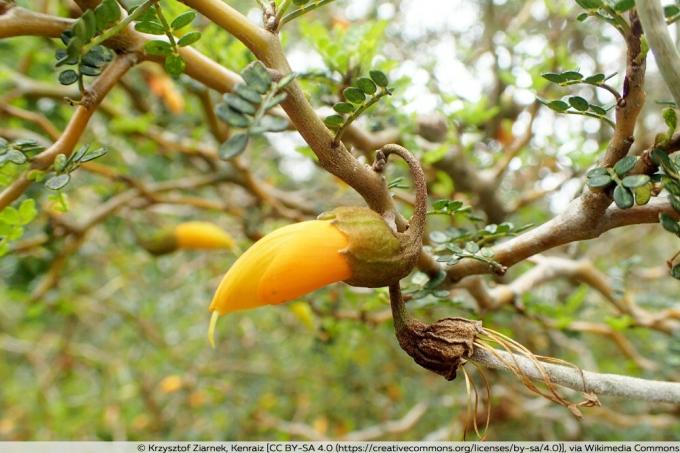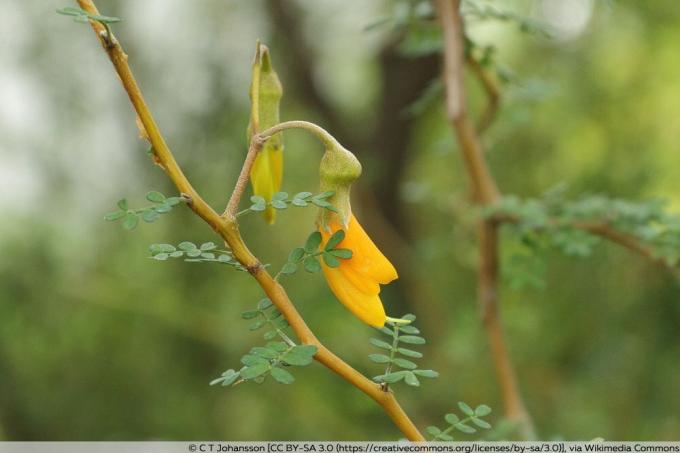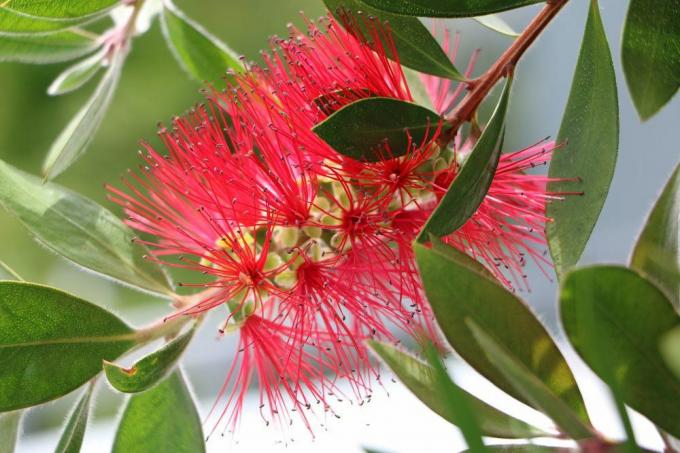
table of contents
- Characteristics
- Location
- floor
- Substrate
- Plants / potting
- Repot
- to water
- Fertilize
- Cut
- wintering
- Plant neighbors
- Multiplication
- sowing
- Cuttings
- Diseases and pests
- Caution, risk of confusion!
Profile and care information open +conclude -
- Flower color
- yellow, orange
- Location
- Partial shade, sunny
- Heyday
- May June
- Growth habit
- upright, dwarf shrub
- height
- up to 2.5 meters high
- Soil moisture
- moderately moist, fresh
- PH value
- neutral
- Limescale tolerance
- Calcium tolerant
- humus
- rich in humus
- Poisonous
- Yes
- Plant families
- Legumes, Fabaceae
- Plant species
- Container plants, houseplants
- Garden style
- Roof garden, inner courtyard, terrace garden, winter garden
The Sophora prostrata, better known as the pagoda tree, has an unusual, interesting appearance. The “Little Baby” variety is particularly popular because of its lush and colorful flowers. Strongly twisting branches give the shrub a bizarre look. As a solitary plant, it can be planted in the garden or in pots on terraces and balconies. In order to enjoy outdoor and indoor plants for a long time, optimal care is essential.
Characteristics
- Name: Schnurbbaum - Variety: Little Baby
- Scientific name: Sophora prostrata
- Alternative / common names: Kowhai, Köwhai, Zigzag
- Plant family: Legumes (Fabaceae)
- Origin: southern New Zealand
- Height / width of growth: 150 to 250 centimeters high, 75 to 150 centimeters wide
- Growth habit: zigzag
- Flowers: yellow-orange from May to June
- Summer green with attractive autumn colors
- Winter hardy: conditionally down to minus 5 degrees Celsius
Location

When it comes to choosing a location, the "Little Baby" tree is picky and reacts quickly if it does not meet its requirements. For this reason, the right location is one of the most important criteria in the field of care.
The Sophora prostrata is considered a houseplant, but keeping it in living spaces is not ideal if there is no minimum humidity there. The lighting conditions should also be optimal, because locations that are too bright or too dark have a serious impact on health and growth. The following describes which requirements the ideal location should meet:
- In the house: full to partly sunny, but protected from direct, hot midday sun
- Outside: partial shade
- Humidity: at least 50 percent
- Sheltered location (thin branches can break quickly in the wind)
- In summer, during flowering, an ideal outdoor space
floor
If the "Little Baby" pagoda tree is planted in the garden bed or in a tub, it needs a soil quality that offers it optimal conditions for supply. These include:
- Rich in humus and nutrients
- Loose and permeable to water
- Gladly slightly calcareous
- pH value: between 6.5 and 7.0
Tip: For better water storage, it is advisable to add some clay granules or coconut fibers to the garden soil so that the soil does not dry out too quickly, especially in summer. A little sand or gravel keeps the soil loose and promotes water permeability.
Substrate

Garden soil that meets the above conditions is usually sufficient for planting in pots. Ready-to-use mixes for indoor and potted plants are also suitable, as are special bonsai soil. It is important that one restricts oneself to high-quality substrate, because inferior products tend to densify quickly and consequently to mold.
Plants / potting
Because the move from familiar circumstances and the change to new soil is always a burden for the plant, the best time for planting and potting is in spring, when the growth phase has started or shortly is imminent. So that frost does not interfere with the establishment of the roots and affects the plant, which has already been weakened by the move, you have to wait until mid-May after the ice saints.
Since this Kowhai variety is only partially winter-proof, it should only be planted in the garden bed in regions with mild winter temperatures. If the winter months are rough, it is advisable to plant them in pots so that the shrub can move to a suitable winter quarters without having to be planted out. When planting and potting, the following procedure should be followed:
- Dig a planting hole or prepare a container
- Plant hole width / depth: double the size of the plant ball
- Bucket size / diameter: double the size of the plant ball
- Fill the bottom of the planter / container about two centimeters high with gravel or quartz sand (for drainage)
- Spread a few centimeters of soil / substrate on the drainage system
- Insert the plant and fill in soil / substrate around it
- The root ball should be about four centimeters below the surface of the earth
- In the case of buckets, make sure that there is at least two centimeters from the upper edge (to prevent flooding)
- Lightly press the soil down after filling
- Pour moderately
Repot
Annual repotting is advisable for young plants in the first three to four years so that they are always supplied with new, fresh substrate with the appropriate nutrient content. The otherwise slow-growing plant, however, thrives more quickly in the first few years, so that the Pot / tub size should be one size larger, so that there is enough space to spread the Gets roots. If the garden and houseplant is older, repotting every two to three years is sufficient, provided the pot / tub does not become too small earlier.

- Carefully remove loose earth with a hand or a hand shovel
- Work extensively around the root
- Caution: if possible, do not damage the roots or loosen the root ball
- Place the pot / bucket on the side and tap lightly on the walls all around (loosens the earth)
- Carefully pull the plant out of the ground (only encompass the lowest area)
- Remove old soil only slightly from roots (a slight shake is sufficient)
- Prepare the bucket / pot and plant the plant in fresh substrate as described under "Planting / potting"
Note: When choosing pots and tubs, it is essential to ensure that there is a drainage hole in the floor so that excess water can run off and waterlogging does not form. Otherwise, this quickly leads to root rot, which can lead to the plant dying off.
to water
When watering, hobby gardeners and flower lovers are asked a lot, because here it is important to always up to ensure continuous moisture without overwatering or drought permit. Especially in summer, this can be a challenge on hot days, because even short-term drought can cause death. Too much water, on the other hand, provokes root rot with the same result as drying out. The following instructions should be followed when watering, so that the garden and houseplant receives ideal care:
- Maximum drying of the earth of 80 percent
- It is better to pour smaller amounts, but more often
- Never water in the sun (risk of burns)
- Optimal watering time early in the morning and later in the evening (especially in full sun locations)
- If the temperature is high, check the moisture content at least twice a day
- For more humidity in summer, spray the plant once or twice a day with water
- Avoid waterlogging by all means
Fertilize
In the first year after planting or potting, the pagoda tree is not fertilized. Fertilization is also not necessary for young plants that are repotted once a year in the first few years. Fertilization therefore only begins with older plants. This is what the fertilizer calendar and the rules for this pagoda tree look like:
- Recommended fertilizer: liquid fertilizer for container plants
- Fertilizing season: from March / April to the beginning of flowering and after flowering to the end of August / beginning of September
- Do not fertilize during the flowering period, otherwise all flowers will fall off
- Fertilizing rhythm: every two to four weeks
- Exception: only use fertilizer pellets, granules or fertilizer sticks once in spring
Cut

The Sophora prostrata shows itself to be very pruning, but does not normally require pruning because it is only growing slowly. If the legume plant is to branch out more and thus grow more densely, pruning the shoots is beneficial. Otherwise, an occasional topiary can make for a more compact look. There is little to consider when cutting:
- Ideal cutting time: at the beginning of the growing season or after flowering until the end of September at the latest
- Shorten shoots by a maximum of a third
- Only cut young shoots - do not cut into old wood
- Always start the cut at an angle (allows moisture to drain off better and consequently cut wounds heal faster)
- Use only cleaned, disinfected cutting tools
Raise it as a bonsai
Due to the slow growth and the unusual appearance, the cultivation of the zigzag bush as a bonsai is particularly popular and can be carried out by anyone without much experience. All that needs to be done is a regular pruning of the roots to further limit the growth of the pagoda tree. The best time to cut is when the annual repotting is due. Here the roots are shortened by about a third. If you do not want it as a bushy and upright bonsai, you can also raise it in a cascade, which requires wire.
wintering
The pagoda tree is not really hardy. It can only survive minus temperatures up to a maximum of five degrees Celsius for a short period of time without suffering any signs of frostbite. While it can overwinter outdoors in mild regions, it should be relocated to a frost-free winter quarters in good time in cold climates.
Outdoor wintering
The pagoda tree survives the winter best in milder areas when it is planted. The roots are protected from the cold by the earth, while this hits the roots unfiltered in a bucket. However, cold protection measures can still be taken here, some of which should not be missing, especially with young plants in the garden bed.
- Cover the soil / substrate in a thick layer with straw, leaves or pine needles
- Cover the bucket with thick foil, cardboard, jute or sticks
- Place the bucket on an insulating surface (e.g. wooden or styrofoam panels)
- Pay attention to a sheltered location or provide for it later
Winter quarters
Not every indoor location is suitable for wintering the “Little Baby” variety. Due to its origin, the plant is used to cooler temperatures during the winter season and should therefore maintain them. The light and humidity conditions also determine whether and how well it can get over the winter months. The following properties make a location the ideal winter quarters:
- Ambient temperature: between five and ten degrees Celsius (colder it can lead to an immense leaf fall)
- Lighting conditions: bright, but no direct sunlight or midday sun
- Humidity: at least 30 percent
- Watering: Do not let the soil dry completely
- Ideal locations: stairwell, unheated winter garden, greenhouse, garden shed or garage with windows
- End of winter time: March / April
- Possible move to the field: from mid-May
Plant neighbors

The pagoda tree is one of the weak eaters and, as a garden plant, can therefore harmonize well with almost all plant species as neighbors. As a container and houseplant, it is an ideal complement to some exotic plants, such as the Australian cylinder cleaner or the Mediterranean lemon Treewith which he jointly creates a holiday feeling.
Multiplication
Anyone who propagates existing plants not only saves money on a sometimes expensive purchase, but also knows exactly what is being used. In addition, growing your own young plants is always an experience. The Sophora prostrata "Little Baby" can be reproduced in two different ways:
sowing
Propagation by sowing requires a little patience from the moment seeds are collected from an existing plant. Alternatively, seeds can of course also be bought in specialist shops, but depending on how old they are and how they are stored the chances of success for germination can be significantly lower than with a “fresh” seed from a mother plant.
- Winter seeds dry and dark until spring at around ten degrees Celsius
- Roughen the surface before sowing and soak in lukewarm water for about 24 hours
- Fill the vessel with potting soil
- Spread seeds on the surface and cover lightly with soil (dark germinator)
- Spray the potting soil moderately with water
- Pull the transparent foil over the pot
- Location: bright without direct sunlight
- Ideal ambient temperature: 21 degrees Celsius
- Open the foil every day and, if necessary, water / spray soil
- If germination is successful, remove the foil
- Pricking: from a size of five centimeters
- When the first leaf formations can be seen, you can plant in normal pots and substrate
- It is imperative that you overwinter the first winter frost-free
Cuttings
In order to be able to carry out the propagation with cuttings promisingly, a healthy mother plant is required. From this shoots with a length between ten and 15 centimeters are separated. The shoots must not be heavily lignified, otherwise the propagation will not work. Proceed as follows for cultivation:
- Time of propagation: spring
- Remove the lower leaves of the cuttings
- Put in a pot filled with potting soil
- Watering: keep evenly moist without overwatering
- Ambient temperature: 15 degrees Celsius
- Lighting conditions: bright but not sunny
- If new leaf roots have formed, transplant in suitable garden soil / substrate
- Do not fertilize in the first year
- Must be kept frost-free in the first year
Diseases and pests
The pagoda tree of the “Little Baby” variety is extremely resistant to diseases and pests. If the plant is cared for as described here, diseases and pest infestation are only to be expected in the rarest of cases. Only root and / or stem rot can be heard more often in the cord tree, but this is mostly due to the fact that too much water has been poured and / or waterlogging has been caused. If the rot is recognized quickly and acted just as quickly, there is a good chance that the zigzag tree can be saved.
Rescue measure
- Plant out immediately (no matter what time of year)
- Gently shake the soil off the root ball
- Allow the roots to air dry for 24 hours
- Slightly shorten the ends of the roots
- Place the plant in new, dry substrate
- Do not water for a few days
- Avoid waterlogging and / or overwatering in the future
Caution, risk of confusion!

In order to properly care for the respective plant species and varieties, it is of course necessary to know them. When buying, the product description usually provides this knowledge, but anyone who receives a plant as a gift, for example, has to find out later. With the “Little Baby” there is quickly the danger that it will be confused with the “Corokia cotoneaster” shrub from the “Saifragaceae” plant family. This is also a zigzag shrub growth. A clear distinguishing feature can be seen on the leaves. The Little Babies have pinnate leaves, while the zigzag shrub Corokia cotoneaster has broad, egg-shaped, about 1.5 centimeters long, dark green single leaves.



